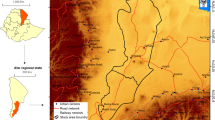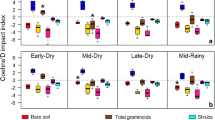Abstract
The effects of the invasive exotic Prosopis juliflora shrubs on the natural plant communities and soil chemical characters were assessed in two regions of the United Arab Emirates (UAE). Five sites were selected subjectively: three in Sharja with 73 stands and two in Ras Al-Khima with 37 stands. Stands were located randomly within each site to cover density variation in Sharja and size variation in Ras Al-Khima. Density, frequency, richness and evenness of the associated annual and perennial species were studied in nine quadrats distributed under, at the margin and outside the canopy of a P. juliflora shrub located in the center of each stand. The results indicated that the effect of P. juliflora on the associated flora depends significantly on the density and size of the canopy. Larger individuals and greater densities have significantly greater negative impacts on the associated plants. All the studied community attributes were significantly lower under P. juliflora canopies than outside. Annuals were inhibited more than perennials. The number of annuals with significant reductions in density and/or frequency under P. juliflora canopies was significantly greater than the number of perennials. Density of more than 50% of the associated annuals was significantly inhibited under P. juliflora canopies. Density of P. juliflora seedlings was greater underneath the canopy of the same species than away from them, indicating little or no self allelopathic effect (auto-inhibition) under field conditions. P. juliflora ameliorated some soil characters, through significant pH reduction and increase in K, N and P and organic matters. Hence, plant diversity might be enhanced following eradication of P. juliflora.
Similar content being viewed by others
References
Al-Humaid AI, Warrag MO (1998) Allelopathic effects of mesquite (Prosopis juliflora) foliage on seed germination and seedling growth of Bermudagrass (Cynodon dactylon). J Arid Environ 38:237–243
Al-Rawai A (2004) Impacts of the alien invasive Prosopis juliflora (Sw.) D.C. on the flora and soils of the UAE and feasibility of its use in afforestation of saline habitats. M.Sc. Thesis, Environmental Science Masters Program, UAE University, Al-Ain, UAE
Aronson J, Ovalle C, Avendano J (1992) Early growth rate and nitrogen fixation potential in forty-four legume species grown in an acid and a neutral soil from central Chile. For Ecol Manage 47:1–4
Arya R (2003) Vegetation status of a salt-affected soil five years after plantation. In: Narain P, Kathju S, Kar A, Singh MP, Kumar P (eds.) Human impact on desert environment. Arid Zone Research Association of India, Jodhpur, India, pp 213–219
Badano EI, Pugnaire FI (2004) Invasion of Agave species (Agavaceae) in south-east Spain: invader demographic parameters and impacts on native species. Divers Distrib 10:493–500
Bais HP, Vepachedu R, Gilroy S, Callaway RM, Vivanco JM (2003) Allelopathy and exotic plant invasion: from molecules and genes to species interactions. Science 301:1377–1380
Barrat-Segretain M (2005) Competition between invasive and indigenous species: impact of spatial pattern and developmental stage. Plant Ecol 180:153–160
Black CA (1965) Methods of soil analysis, Part 2. In: Black CA (ed) Agronomy monograph No 9. American Society of Agronomy, Madison, WI, pp 771–1572
Blossey B, Nuzzo V, Hinz H, Gerber E (2001) Developing biological control of Alliaria petiolata (M. Bieb.) Cavara and Grande (garlic mustard). Nat Areas J 21:357–367
Brewer JS (2002) Disturbances increase seedling emergence of an invasive native shrub in pitcher-plant bogs. Nat Areas J 22:4–10
Brooks ML, Pyke DA (2001) Invasive plants and fire in the deserts of North America. In: Galley KEM, Wilson TP (eds.) Proceedings of the invasive species workshop: the role of fire in the control and spread of invasive species, Fire Conference 2000: the First National Congress on Fire Ecology, Prevention, and Management, Miscellaneous Publication No. 11, Tall Timbers Research Station, Tallahassee, Fl, pp 1–14
Cadotte MW, Murray BR, Lovett-Doust J (2005) Using database analyses to test widespread ecological generalities in invasions biology. Biol Invasions (In Press)
Chellamuthu V, Balasusbramanian TN, Rajarajan A, Palaniappan SN (1997) Allelopathic influence of Prosopis juliflora (Swartz) DC. on field crops. Allelopathy J 4:291–302
Collier MH, Vankat JL, Hughes MR (2002) Diminished plant richness and abundance below Lonicera maackii, an invasive shrub. Am Midl Nat 147:60–71
Dunbar KR, Facelli JM (1999) The impact of a novel invasive species, Orbea variegata (African carrion flower), on the chenopod shrublands of South Australia. J Arid Environ 41:37–48
El-Keblawy A, Al-Rawai A (2005) Effects of salinity, temperature and light on germination of invasive Prosopis juliflora (SW.) D.C. J Arid Environ 61:555–556
El-Keblawy A, Ksiksi T (2005) Artificial forests as conservation sites for native flora of the UAE. For Ecol Manage 213:288–296
Ewe SML, Sternberg LSL (2003) Seasonal gas exchange characteristics of Schinus terebinthifolius in a native and disturbed upland community in Everglades National Park, Florida. For Ecol Manage 179:27–36
Fischer RA, Reese KP, Connelly JW (1996) An investigation on fire effects within xeric sage grouse brood habitat. J Range Manage 49:194–198
Frankel E (1999) A floristic survey of vascular plants of the Bronx River Parkway Reservation in Westchester, New York: compilation 1973–1998. J Torrey Bot Soc 126:359–366
Garg VK, Singh B (2003) Macronutrient dynamics and use efficiency in three species of short rotation forestry developed on sodic soils in North India. J Trop For Sci 15:289–302
Garner W, Steinberger Y (1989) A proposed mechanism for the formation of ‘fertile islands’ in the desert ecosystem. J Arid Environ 16:257–262
Ghazanfar SA (1996) Invasive Prosopis in Sultanate of Oman. Aliens 3:10
Goel VL, Behl HM (1999) Screening of Prosopis germplasm for afforestation of degraded soil sites: performance, leaf nutrient status and influence on soil properties. J Sustain For 8:1–13
Gomathi V, Kannabiran B (2000) Inhibitory effects of leaf extracts of some plants on the anthracnose fungi infecting Capsicum annum. Indian Phytopathol 53:305–308
Gordon DR (1998) Effects of invasive, non-indigenous plant species on ecosystem processes-lessons from Florida. Ecol Appl 8:975–989
Hagos MG, Smit GN (2005) Soil enrichment by Acacia mellifera subsp. detinens on nutrient poor sandy soil in a semi-arid southern African savanna. J Arid Environ 61:47–59
Harrod RJ (2001) The effect of invasive and noxious plants on land management in eastern Oregon and Washington. Northwest Sci 75:85–90
Hoffmann WA, Lucatelli VMPC, Silva FJ, Azeuedo INC, Marinho MS, Albuquerque AMS, Lopes AO, Moreira SP (2004) Impact of the invasive alien grass Melinis minutiflora at the savanna-forest ecotone in the Brazilian Cerrado. Divers Distrib 10:99–103
Kamalakannan A, Shanmugam V, Surendran M, Srinivasan R (2001) Antifungal properties of plant extracts against Pyricularia grisea, the rice blast pathogen. Indian Phytopathol 54:490–492
Kedzie-Webb SA, Sheley RL, Borkowski JJ, Jacobs JJ (2001) Relationships between Centaurea maculosa and indigenous plant assemblages. Western North Am Nat 61:43–49
Kothari AK, Jain PM (2003) Effect of tree species on inter space grass yield under silvopastoral system. In: Narain P, Kathju S, Kar A, Singh MP, Kumar P (eds.) Human impact on desert environment, Arid Zone Research Association of India, Jodhpur, India, pp 393–396
Lesica P, Miles S (2001) Natural history and invasion of Russian olive along eastern Montana rivers. West North Am Nat 61:1–10
Lockhart CS, Austin DF, Jones WE, Downey LA (1999) Invasion of carrotwood (Cupaniopsis anacardioides) in Florida natural areas (USA). Nat Areas J 19:254–262
Lonsdale WM (1999) Global patterns of plant invasions and the concept of invisibility. Ecology 80:1522–1536
Menezes RSC, Salcedo IH, Elliott ET (2002) Microclimate and nutrient dynamics in a silvopastoral system of semi-arid northeastern Brazil. Agroforest Syst 56:27–38
Nakano H, Fujii Y, Suzuki T, Yamada K, Kosemura S, Yamamura S, Hasegawa K (2001) A growth-inhibitory substance exuded from freeze-dried mesquite (Prosopis juliflora (Sw.) DC.) leaves. Plant Growth Regul 33:165–168
Nakano H, Nakajima E, Hiradate S, Fujii Y, Yamada K, Shigemori H, Hasegawa K (2004) Growth inhibitory alkaloids from mesquite (Prosopis juliflora (Sw.) DC.) leaves. Phytochemistry 65:587–591
Noor M, Salam U, Khan MA (1995) Allelopathic effects of Prosopis juliflora Swartz. J Arid Environ 31:83–90
Orr SP, Rudgers J, Clay K (2005) Invasive plants can inhibit native tree seedlings: testing potential allelopathic mechanisms. Plant Ecol 181:153–165
Pattison RR, Goldstein G, Ares A (1998) Growth, biomass allocation and photosynthesis of invasive and native Hawaiian rainforest species. Oecologia 117:449–459
Prieur-Richard AH, Lavorel S., Linhart YB, Dos Santos A (2002) Plant diversity, herbivory and resistance of a plant community to invasion in Mediterranean annual communities. Oecologia 130:96–104
Pugnaire FI, Haase P, Puigdefabregas J, Cueto M, Clark SC, Incoll LD (1996) Facilitation and succession under the canopy of a leguminous shrub, Retam sphaerocarpa, in a semi-arid environment in south-east Spain. Oikos 76:455–464
Ridenour MW, Callaway RM (2001) The relative importance of allelopathy in interference: the effect of an invasive weed on a native bunchgrass. Oecologia 126:444–450
Sharma R, Dakshini KMM (1998) Integration of plant and soil characteristics and the ecological success of two shape Prosopis species. Plant Ecol 139:63–69
Shiferaw H, Teketay D, Nemomissa S, Assefa F (2004) Some biological characteristics that foster the invasion of Prosopis juliflora (Sw.) D.C. at Middle Awash Rift Valley Area, north-eastern Ethiopia. J Arid Environ 58:134–153
Smith MD, Knapp AK (2001) Physiological and morphological traits of exotic, invasive exotic, and native plant species in tallgrass prairie. Int J Plant Sci 163:785–792
Tiwari JWK (1999) Exotic weed Prosopis juliflora in Gujarat and Rajasthan, India-boon or bane. Tigerpaper 26:21–25
Vetaas OR (1992) Micro-site effects of shrubs in dry savannas. J Veg Sci 3:337–344
Vitousek PM, Mooney HA, Lubchenco J, Melillo JM (1997) Human domination of Earth’s ecosystems. Science 227:494–499
Wardle DA, Nilsson MC, Gallet C, Zackrisson O (1998) An ecosystem-level perspective of allelopathy. Biol Rev Camb Philos Soc 73:305–319
Warrag MOA (1994) Autotoxicity of mesquite (Prosopis juliflora) pericarps on seed germination and seedling growth. J Arid Environ 27:79–84
Warrag MOA (1995) Autotoxic potential of foliage on seed germination and early growth of mesquite (Prosopis juliflora). J Arid Environ 31:415–421
Western RA (1989) The Flora of the United Arab Emirates: an introduction. UAE University Publications, Al-Ain, UAE
Zalba SM, Sonaglioni MI, Compagnoni CA, Belenguer CJ (2000) Using a habitat model to assess the risk of invasion by an exotic plant. Biol Conserv 93:203–208
Acknowledgements
This work was financially supported by the Research Affairs at the UAE University Under a contract no. 18-2-11/01. The authors are grateful to Marc Cadotte, Dept of Ecology and Evolutionary Biology, University of Tennessee, Jon Lovett-Doust, University of Windsor, Canada, Taoufik Ksiksi and Tony Quirke, UAE University, for their critical revision of the manuscript.
Author information
Authors and Affiliations
Corresponding author
Rights and permissions
About this article
Cite this article
El-Keblawy, A., Al-Rawai, A. Impacts of the invasive exotic Prosopis juliflora (Sw.) D.C. on the native flora and soils of the UAE. Plant Ecol 190, 23–35 (2007). https://doi.org/10.1007/s11258-006-9188-2
Received:
Accepted:
Published:
Issue Date:
DOI: https://doi.org/10.1007/s11258-006-9188-2




